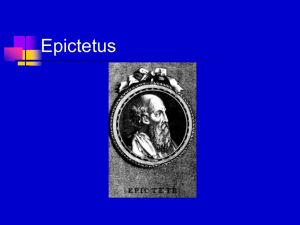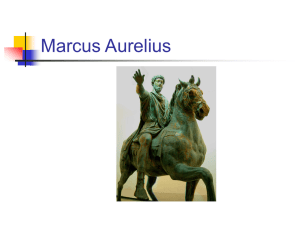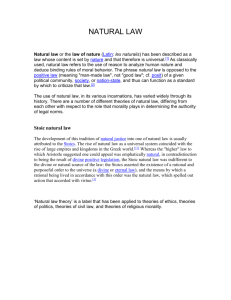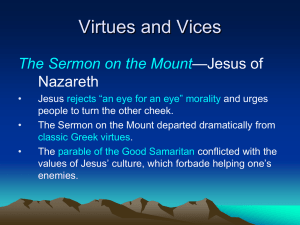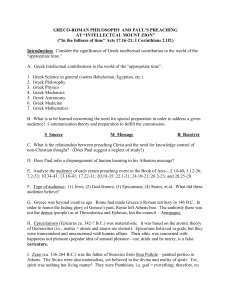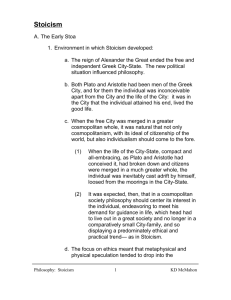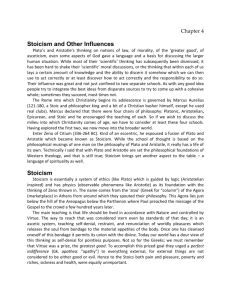a non-liberal justification for toleration
advertisement
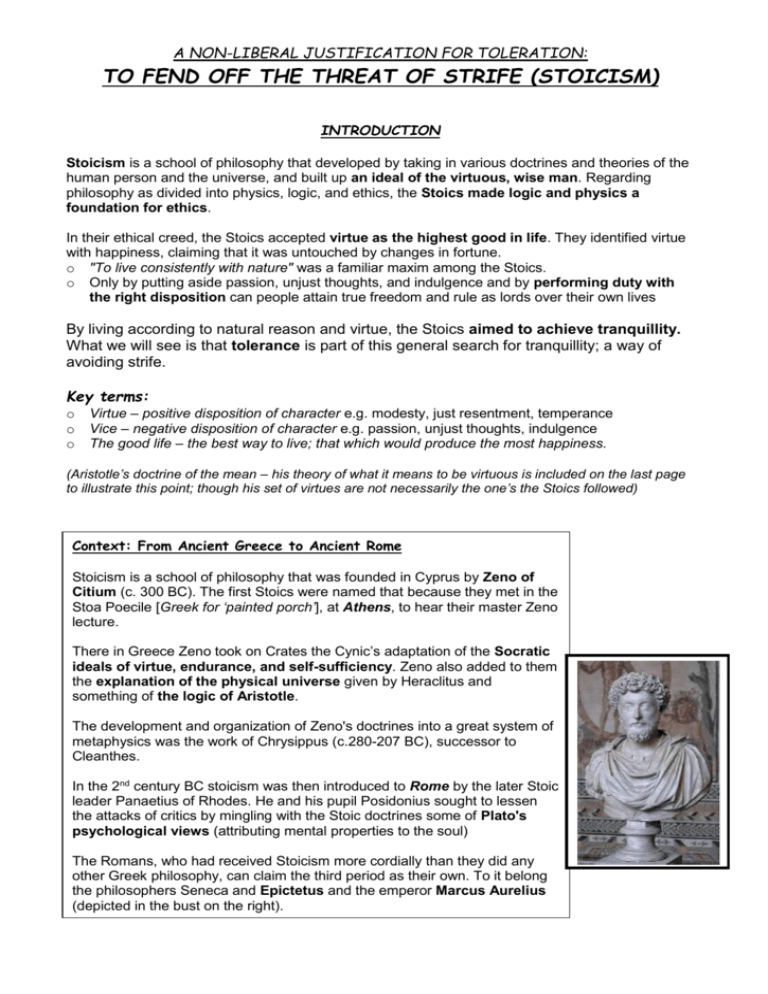
A NON-LIBERAL JUSTIFICATION FOR TOLERATION: TO FEND OFF THE THREAT OF STRIFE (STOICISM) INTRODUCTION Stoicism is a school of philosophy that developed by taking in various doctrines and theories of the human person and the universe, and built up an ideal of the virtuous, wise man. Regarding philosophy as divided into physics, logic, and ethics, the Stoics made logic and physics a foundation for ethics. In their ethical creed, the Stoics accepted virtue as the highest good in life. They identified virtue with happiness, claiming that it was untouched by changes in fortune. o "To live consistently with nature" was a familiar maxim among the Stoics. o Only by putting aside passion, unjust thoughts, and indulgence and by performing duty with the right disposition can people attain true freedom and rule as lords over their own lives By living according to natural reason and virtue, the Stoics aimed to achieve tranquillity. What we will see is that tolerance is part of this general search for tranquillity; a way of avoiding strife. Key terms: o o o Virtue – positive disposition of character e.g. modesty, just resentment, temperance Vice – negative disposition of character e.g. passion, unjust thoughts, indulgence The good life – the best way to live; that which would produce the most happiness. (Aristotle’s doctrine of the mean – his theory of what it means to be virtuous is included on the last page to illustrate this point; though his set of virtues are not necessarily the one’s the Stoics followed) Context: From Ancient Greece to Ancient Rome Stoicism is a school of philosophy that was founded in Cyprus by Zeno of Citium (c. 300 BC). The first Stoics were named that because they met in the Stoa Poecile [Greek for ‘painted porch’], at Athens, to hear their master Zeno lecture. There in Greece Zeno took on Crates the Cynic’s adaptation of the Socratic ideals of virtue, endurance, and self-sufficiency. Zeno also added to them the explanation of the physical universe given by Heraclitus and something of the logic of Aristotle. The development and organization of Zeno's doctrines into a great system of metaphysics was the work of Chrysippus (c.280-207 BC), successor to Cleanthes. In the 2nd century BC stoicism was then introduced to Rome by the later Stoic leader Panaetius of Rhodes. He and his pupil Posidonius sought to lessen the attacks of critics by mingling with the Stoic doctrines some of Plato's psychological views (attributing mental properties to the soul) The Romans, who had received Stoicism more cordially than they did any other Greek philosophy, can claim the third period as their own. To it belong the philosophers Seneca and Epictetus and the emperor Marcus Aurelius (depicted in the bust on the right). STOICISM AND THE GOOD LIFE What is the ‘good life’? In philosophy, the notion of the ‘good life’ relates to the best way to live; the way of living that will produce the most happiness. The Stoics drew on, and developed, Socrates’ notion of the good life which was as follows: o o o o o o Socrates believed the best way for people to live was to focus on self-development rather than the pursuit of material wealth. He always invited others to try to concentrate more on friendships and a sense of true community, for Socrates felt this was the best way for people to grow together as a populace. His actions lived up to this: in the end, Socrates accepted his death sentence when most thought he would simply leave Athens, as he felt he could not run away from or go against the will of his community; as mentioned above, his reputation for valour on the battlefield was without reproach. The idea that humans possessed certain virtues formed a common thread in Socrates' teachings. These virtues represented the most important qualities for a person to have, foremost of which were the philosophical or intellectual virtues. Socrates stressed that "virtue was the most valuable of all possessions; the ideal life was spent in search of the Good. Truth lies beneath the shadows of existence, and it is the job of the philosopher to show the rest how little they really know." The Stoic good life: tranquillity The Stoic idea of the good life is tranquillity: to be free of suffering through apatheia (apathy) or peace of mind (literally, 'without passion'). o Peace of mind here is understood in the ancient sense — being objective or having ‘clear judgment’ and the maintenance of equanimity (level-headedness) in the face of life's highs and lows. Today the word 'stoic' has come to mean 'unemotional' or indifferent to pain, because Stoic ethics taught freedom from 'passion' by following 'reason.' But this is a caricature of Stoicism. o o o The Stoics did not seek to extinguish emotions, rather they sought to transform them by a resolute 'askēsis' (training in terms of abstinence) which enables a person to develop clear judgment and inner calm. Logic, reflection, and concentration were the methods of such self-discipline. Stoicism asks us to develop proper emotion (euphathis) or measured emotion (metriphathia). To achieve tranquillity we need to attain self-mastery. The complete lack of passion is clearly not the conclusion of Stoicism. Rather, the goal of Stoicism is to restrain passion properly under the guidance of reason. The unifying law of reason in Stoicism For the Stoics, 'reason' is not just logic, but an understanding of the processes of nature — the logos, or universal reason, inherent in all persons. o Living according to reason and virtue, they held, is to live in harmony with the divine order of the universe. o This is a recognition of the common reason and essential value of all people. o The four cardinal virtues of which all persons have the capacity to pursue are: o wisdom (Sophia), o courage (Andreia), o justice (Dikaiosyne), o temperance (Sophrosyne) It is the pursuit of these virtues that will lead to tranquillity. STOICISM AND TOLERANCE In relation to the notion that the good life was one of tranquillity, the Stoics were well aware of the natural diversity in the world. o o Humans are empirically different, and the pursuit of virtue will result in diverse human lives. Hence each person should thus focus on his own duties and character and ‘not wish to try how another man’s would suit him’. Yet this diversity is held together by the unifying law of reason inherent in all persons. The tension between this universality and difference is the space of toleration: Stoics tolerate differences, as long as those differences do not violate this natural law of reason. Individuals are to be respected in so far as they are members of the natural community of reason; all are equal before this law. For Stoics, then, tolerance is part of a general search for tranquillity and self-mastery in this world of diversity, conflict, illusion, vanity and ignorance. It is for the threat of strife that we should be tolerant, and a general account of how this toleration is enacted in Stoicism comes from two directions. 1. Stoics modestly recognise the limits of our fallible imaginations. o Rather than being sceptical of our own beliefs, as we saw with Barry’s fallibility argument for toleration, the Stoics consider the fallibility of our imaginations in understanding the morals of others. o Modest assessment of one’s own capacity to judge the other can ground toleration towards the other without becoming moral sceptic. o Modesty does not ask us not to judge the other but merely to admit our limits to do so. o So basically, the acceptance component of Stoic toleration concerns the acknowledgement of our own fallible imaginations (inability to fully judge others). In this way, modesty and tolerance are part of the philosophical life spent in pursuit of selfknowledge. o 2. For Stoics the task of philosophy is to help us to properly distinguish between those things which are in our power and those things which are not. o o o o Concerning the natural diversity in the world, tolerance results when we realise that the activities of others are not in our power. It is important to note that there are uncontrollable externalities – including the actions of those with whom we disagree. This is because such recognition is conducive to a life of virtue because it helps us to attain selfmastery by allowing us resentment, while also cultivating mercy and magnanimity (highmindedness). In other words, we should know which fights are worth fighting, and understand that not all of them are. This will fend off the threat of undue strife in our lives. But is this to say that Stoics are indifferent rather than tolerant? This is where we find strengths and weaknesses with the Stoic argument for toleration STRENGTHS AND WEAKNESSES OF THE STOIC ARGUMENT FOR TOLERATION: TO FEND OFF THE THREAT OF STRIFE A STRENGTH: Stoic tolerance as put into practice by Marcus Aurelius Roman emperor from 161 to his death in 180, Marcus Aurelius was the last of the "Five Good Emperors", and is also considered one of the most important Stoic philosophers. We refer to philosophers who are political rulers as philosopher-kings. Concerning the question of indifference, with Marcus as an emperor, his position does not allow him to withdraw from all opposition. Marcus shows Stoic tolerance in relation to the good life can work. o Stoicism maintains that there is a human ideal of virtue that includes human interaction and social responsibility. Indeed a concern for justice demands active intervention in some cases – persuasion rather than coercion being the favoured intervention. Furthermore, while apathy towards those things over which we have no power is a goal, complete indifference to others would hinder our pursuit of the ultimate good for human beings, which includes justice, friendship and other social virtues. A Stoic account of toleration must thus link concern for others with an understanding of the need for controlling our own judgements and emotions under a general idea of impartiality. The point is that even in such cases, social interaction is guided by the spirit of tolerance in attaining tranquillity in life rather than conflict. o o o o Here the Stoic position, as exemplified by Marcus, is expressed in terms of Forst’s concept of toleration: o The objection component of Stoic toleration is based in the notion that justice requires critical engagement with those we tolerate, even while reason requires proper control of our emotional reactions when confronted by practices or beliefs that are objectionable. o Remember, the acceptance component of Stoic toleration is that we have to be modest with our own beliefs and not impose them on others, due to the fallibility of our moral imaginations. For the Stoic, the best way to contribute to the development of virtue in rational adults is to avoid coercion and, instead, appeal to argument and their natural capacity for the universal law of reason. o And, finally, the rejection component in Stoic tolerance is that since they believe the development of moral autonomy is good, tolerance requires that we confront those with whom we disagree and exhort, admonish, argue and attempt to persuade them towards the truth (an embracing of the unifying law of reason and of tranquillity). Furthermore, the limits of toleration are set out in the Stoic position, it that while it maintains that we should argue with our opponents while admitting that it would be unwise to become indignant and unjust to interfere, we should interfere where necessary (e.g. when conflict led to war). A WEAKNESS: Epictetus shows us Stoic tolerance is dependent on social standing. However, as a philosopher-king, Marcus was in a position where he could practice the kind of tolerance just described. As emperor he had more power than most, and an even greater obligation to be magnanimous and tolerant towards those he governed. As the Stoic philosopher Seneca concludes: ‘For a king, even a raised voice and intemperate language are a degradation of majesty.’ But how is tolerance practiced by all the other followers of Stoicism? We can look at the example of Epictetus – a very important proponent of Stoic philosophy - to see Stoic tolerance as practiced by the philosopher-slave. One major weakness is that the Stoic argument for tolerance is dependent on social standing. Born a slave, for Epictetus, tolerance descends into indifference for he is not in a position to challenge the other in order to reach tranquillity, he can only accept his lack of control (the second direction of Stoic toleration). The following quotes show how Epictetus’ approach to tolerance is something closer to slavish submission to the will of the other than it is the deliberate restraint of his power to impose his beliefs upon his opposition: o ‘Remember that what is insulting is not the person who abuses you or hits you, but the judgement about them that they are insulting. So when someone irritates you be aware that what irritates you is your own belief.’ Here Epictetus endures, rather than tolerates. o ‘When someone acts badly towards you or speaks badly of you, remember that he does or says it in the belief that it is appropriate for him to do so… Starting from these considerations you will be gentle with the person who abuses you. For you must say on each occasion, “That is how it seemed to him”’. This quote is leaning towards toleration, rather than mere submission, as the notion of being ‘gentle’ suggests you could act otherwise. However, there appears to be a lack of objection to the opponent’s ‘belief that it is appropriate’ to insult. o ‘To the rational being only the irrational is unendurable but the rational is endurable … Now it so happens that the rational and the irrational are different for different persons … For to one man it is reasonable to hold a chamber pot for another … But some other man feels that it is not merely unendurable to hold such a pot himself, but even to tolerate another’s doing so.’ This passage suggests relativism follows from a lack of courage and strength to remain committed to a concrete idea of the good. It is as if Epictetus is trying to reconcile himself and others who are at the low end of the social ladder to the inevitability of oppression. This is not toleration, but resignation. In conclusion, Epictetus repeatedly counsels us to ignore the uncontrollable nature of external life and to prepare to endue the ills that inevitably afflict us all. As Isaiah Berlin put it, Epictetus’ approach is a ‘retreat to the inner citadel’ which is completely opposed to any robust idea of social life or political freedom. So a major criticism, then, is that considering the uncontrollable externalities that lead to strife, in order to achieve the good life of tranquillity a philosopher-slave would have to settle for being indifferent towards such opposition, while only a philosopher-king – or at least those of a high social status – could actually practice tolerance of such opposition. * For further pros and cons: Consider whether tying tolerance to a conception of the ‘good life’ is a good idea.
